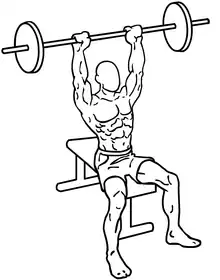Overhead press
The overhead press, also known as the shoulder press or military press, is an upper-body weight training exercise in which the trainee presses a weight overhead while seated or standing. It is mainly used to develop the anterior deltoid muscles of the shoulder.[1] The standing version was once a component of the sport of Olympic weightlifting as part of the clean and press movement, but was removed in 1972 due to difficulties in judging proper technique.

The lift is set up by taking either a barbell, a pair of dumbbells or kettlebells, and holding them at shoulder level. The weight is then pressed overhead.[2] While the exercise can be performed standing or seated, standing recruits more muscles as more balancing is required in order to support the lift.[3] Other variations of the exercise include the push press, a similar movement that involves an additional dipping motion in the legs to increase momentum.[1] An overhead press may also be performed unilaterally, with the lift being performed one handed; or in an alternating fashion with both hands holding a dumbbell or kettlebell, and then pressing with one arm and then the other.[4]
See also
References
- Boly, Jake (16 March 2021). "The Overhead Press May Just Be the Best Pressing Movement Around". BarBend. Retrieved 2022-03-25.
- "How To Overhead Press: A Beginner's Guide". Bodybuilding.com. 2015-08-12. Retrieved 2018-09-11.
- "The Overhead Press: The Difference Between Seated, Standing, Dumbbell and Barbell". Breaking Muscle. 17 March 2022.
- Boyle, Michael (2016). New Functional Training for Sports. Champaign: Human Kinetics. p. 168. ISBN 978-1-4925-3061-9.
Further reading
- Rippetoe, Mark; Kilgore, Lon (2007). Starting Strength: Basic Barbell Training. ISBN 978-0-9768054-2-7.
- Kapandji, Ibrahim Adalbert (2007). The Physiology of the Joints: The upper limb. ISBN 978-0-443-10350-6.